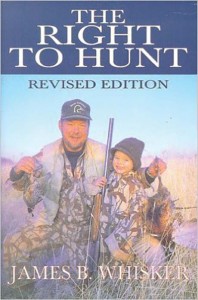Review by Larry S. Sterett | Contributing Editor
THE RIGHT TO HUNT, Revised Edition, by James B. Whisker. Published by Merrill Press, Dept. TGM, P . Box 1682, Bellevue, WA 98009. Price: $16.95, plus postage.
 This 220-page softbound volume was first published more than a decade ago, but this revised edition is up to date in the defense of hunting. The author, probably best known for his book, Our Vanishing Freedom: The Right to Keep and Bear Arms, has provided reading sportsmen with much solid information to combat those who would try to take away our right to hunt.
This 220-page softbound volume was first published more than a decade ago, but this revised edition is up to date in the defense of hunting. The author, probably best known for his book, Our Vanishing Freedom: The Right to Keep and Bear Arms, has provided reading sportsmen with much solid information to combat those who would try to take away our right to hunt.
Following a brief Introduction, and a Foreword with a quote from Meditations on Hunting by the late (1883-1955) Spanish philosopher Jose Ortega y Gasset, this book contains a dozen chapters, a bibliography and an index. The chapter topics range from ‘On the Pleasures of Hunting,’ through ‘Our Endangered Wildlife,’ and include ‘Is it Ethical to Hunt?,’ ‘Animal Rights?,’ and ‘The Legal Right to Hunt.’ There are no illustrations, sidebars, graphs, or charts, but each chapter contains endnotes.
Chapter2, ‘Man the Hunter,’ makes the point that man became a hunter because of his heavy meat-eating habit. Further that early man probably hunted in bands, and was using wooden spears some 400,000 years ago. Although he may have varied his diet by including seeds, nuts, berries, grasses, etc., these were luxury items. They were not alone capable of sustaining human life indefinitely, and scavenging was not a dependable method for obtaining a ready supply of meat. Hence, man became a predator, but had to develop weapons for hunting in lieu of an adequate physical structure.
Chapters 5 and 6, ‘The Amerindian and Hunting,’ and ‘Hunting and the American Experience,’ bring the subject of hunting up to the present. While some hunting today is done to provide meat, much is done for other reasons, the edible meat is a bonus.
Hunters have proven to be valuable assets in the military, not for their meat-gathering ability, but for their marksmanship. Sergeant Alvin York of WWI fame was known for his hunting skills, as was Audie Murphy in World War II. The white-clad Finnish hunters held off the Russian Army for a period of time in the early days of World War II, and Russian and German hunters as snipers thinned each other’s ranks throughout the war. (Chapter 10, ‘The Right to Hunt and National Defense,’ is worth reading twice, as is Chapter 8, ‘Hunting and Ethics.’ This last chapter summarizes the six principal arguments used against hunting by members of the majority of the anti-hunting fraternity.)
This book is an excellent reference source on the subject—The Right to Hunt. It may not have all the answers, but it provides adequate material to use in any discussion with anti-hunting activists. Every hunter needs to read it and savor the information therein.



